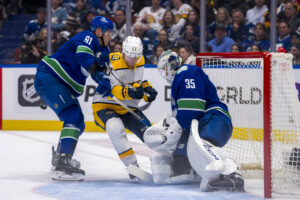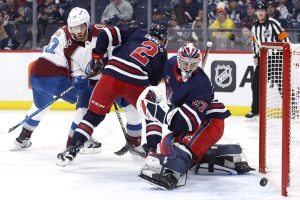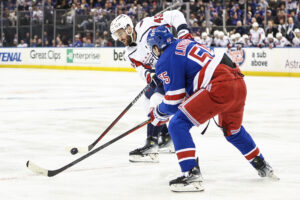The Chicago Steel of the USHL recently won the Clark Cup. They have several talented players that are eligible for the 2021 NHL Draft, including the likes of Matthew Coronato, Mackie Samoskevich and Ryan Ufko. There is one more prospect, however, who did not play a very large role. That player was defenseman Lukas Gustafsson. Gustafsson will be returning to the Steel next season and will have a larger role, but he has some underlying skills that make him a sleeper pick in the 2021 class.
Lukas Gustafsson Prospect Deep Dive
What The Experts Are Saying about Lukas Gustafsson
Josh Tessler of Smaht Scouting: “If you are looking for a versatile defender, who can serve as a defensive forward, but who possesses the ability to create scoring chances in the offensive zone then Lukas Gustafsson is your man… Gustafsson is a Swiss army knife. Wherever you need him to be, he will be there and deliver. I could go on and on about his versatility, but he reminds me of former Boston Red Sox fan favourite and now Texas Rangers hitter Brock Holt. Like Holt, Gustafsson will step in and play wherever you desire.”
Ben Kerr of the Last Word: “Some nice tools but playing on a stacked team makes his projection more difficult. Would have loved to see him in more minutes and tougher minutes. Not his fault but we didn’t see it. Worth a flier on.”
Lukas Gustafsson Draft Profile
Gustafsson, born December 16th, 2002, out of Alpharetta, Georgia, is an 18-year-old left-shot defender. Standing at 5’10” and 181 pounds, Gustafsson played in a limited capacity with Chicago. He slotted into just 14 regular-season games with one goal and three assists for four points. On top of the 14 USHL games, he also played four high school games with Cushing Academy, wearing the “C” and scoring two goals and seven assists for nine points.
Gustafsson lands at 100th on my list of prospects, landing him in the early fourth round. He’s also been ranked 64th by Dobber Prospects and 81st by Smaht Scouting. However, he also comes in at 186th among North American skaters on NHL Central Scouting’s list, which puts him in a weird spot in terms of where to realistically expect him to be picked.
Skating Abilities
To begin, we will look at Gustafsson’s skating abilities. His skating is solid, featuring above-average speed. His edges do need some work, as does his acceleration. It starts with his cross-overs, as he jumps rather than pushes off his back foot. If he can extend his stride and also widen it, his acceleration will show noticeable growth. As for his edges, he relies very heavily on his inside edges, especially when engaging with a battle along the boards. He will stop on one foot, and drag the other foot behind. Utilizing his outside edges showed some difficulty, as those scenarios led to him being off-balance.
As for his straight-line skating, Gustafsson shows fairly good technical ability. He displays good ankle flexion, keeping his knee’s over his toes consistently. His stride length is solid, though not consistent. He’ll need some fine-tuning in that aspect of his skating. Finally, his knee bend also needs a little bit of work. He does not bend his knees enough, and it takes away some power in his stride. If he can adjust that, he’ll be a faster and stronger skater.
Lukas Gustafsson’s Transitional Abilities
Arguably, Lukas Gustafsson’s best trait that he displayed with the Steel in a limited capacity was his transitional play. He attacked with regularity up the ice and through the neutral zone, rarely backing down. Quick decision-making and passing led to quick entries and exits for his teammates. Additionally, he has the ability to connect on stretch passes to set up breakaways when the situation calls for it. In fact, when it came to exiting the defensive zone, he did so with possession on 66.66% of his attempts. That ranked first among other USHL and NCAA draft-eligibles I tracked, which included the likes of Luke Hughes, Owen Power (NCAA) and Sean Behrens.
When it came to entering the offensive zone, Gustafsson did so with possession on 40% of his attempts. That ranked last among those same USHL/NCAA defenders I tracked this season, but he wasn’t terrible either. To put that in perspective, the average controlled entry percentage among those tracked defenders was 46.03%, putting Gustafsson just below that mark. If he was given a bigger role this season, it’s likely that number is a little better.
Offensive Game
Gustafsson used to be a forward. In fact, there were points with the Steel where Gustafsson would be deployed as a winger. That offensive mindset from those years as a forward is displayed every single time his team enters the offensive zone. But again, his small role in Chicago limited the impact he had on my data. Completing just three of his five total passes in the games I tracked, Gustafsson simply didn’t get many opportunities. In those five pass attempts, only one was a high-danger pass attempt, and he failed to complete that pass. His other four attempts were high-to-low passes and simple passes.
In terms of his shooting ability, he again had a small impact. Attempting just three shots, he hit the net every time. One shot came from low-danger, one from medium-danger, and one from high-danger. His ability, despite limited ice time, to get pucks into high-danger, or at least look for those opportunities, is what makes Gustafsson an intriguing late-round option.
Lukas Gustafsson’s Offensive Style
As mentioned earlier, Gustafsson used to play forward and was deployed as a winger in the USHL at various times. His offensive game is predicated on his shifty skating ability, vision without the puck, and a strong sense of anticipation. When watching Gustafsson, you’ll notice he doesn’t stop moving his feet in the offensive zone, and he’s always looking to find open space.
e shows an adept ability to anticipate when to jump up in the play and help the forwards out down low, or to sneak in low for a scoring chance. However, he knows when not to jump up as well. There were times where there was space in front of him to take, but his teammate was facing tight pressure. He decided to stick back and be responsible on defence rather than to take a very high-risk chance that could lead to an odd-man rush the other way.
Lukas Gustafsson’s Defensive Zone Ability
Gustafsson shows that same motor in the defensive zone that he shows in the offensive zone. He’s always moving his feet, engaging the puck carrier when they are attacking, and knows how to angle attackers to the wall and keep pucks out of the slot. However, still being relatively new to the position as a defender, there are times where he gets out of position due to puck-watching or chasing. Additionally, and this is shown on the rush, he’ll lose focus of what side he is defending and cut all the way across to his linemates half of the ice to stop a rush chance against his team. His skating isn’t NHL-ready yet, and it’ll be some time before it is, so this chasing in the neutral zone to defend the rush will not work at the next level for him.
Overall though, Gustafsson is strong at defending the rush. He has a strong stick, able to knock pucks away from attacking forwards often. His gaps need some work, but he is very difficult to gain inside position on, so he almost always gets the attacker to the outside, and uses what was a loose gap to his advantage by quickly closing in on the perimeter. In the games I tracked, he successfully broke up a rush chance on 41.67% of rushes directed towards his half of the ice. That landed him in first among those same USHL/NCAA defenders I tracked. He allowed a clean entry on 25% of attempts as well, which placed him second behind teammate Ryan Ufko.
Lukas Gustafsson’s NHL Comparison and Potential
Gustafsson has upside as a future second pair defender. His offence is tantalizing and he shows a strong understanding of defensive zone structure already despite not playing much as a defenseman before. However, his style is difficult to project to the NHL level, and with his skating needing some work paired with his flaws in defending his own end, he is a bit of a risk with a low floor. Despite that, next season will be the year everyone will be looking out for him as he gets a bigger role in the USHL. He could seriously break out in his DY+1 season and make a lot of general managers look stupid. He’s well-worth the upside if he is available in the mid-to-late rounds.
As for a comparison, based on style only, he reminds me of P.K. Subban. Subban loves to act as a fourth forward, and in his prime years, was a strong asset in the transitional aspect of the game. Additionally, his defensive zone play was never great, but he was not a liability there, either. While Gustafsson seemingly weighs his risk-taking a little bit more closely than Subban did in his prime years, he still jumps up in the play and pushes the pace similar to that of the New Jersey Devils defenseman.
Main Photo:
Tough loss last night but Pens are back in action today at 1pm vs. @DeerfieldBVH Join us as we celebrate our lone on-campus senior Lukas Gustafsson. Lukas has been a rock on D these past seasons and a great captain for our young team this winter! #RollPens 🐧 pic.twitter.com/H7suXOcUUz
— Boys’ Hockey | Cushing Academy (@CushingBHockey) March 13, 2021






